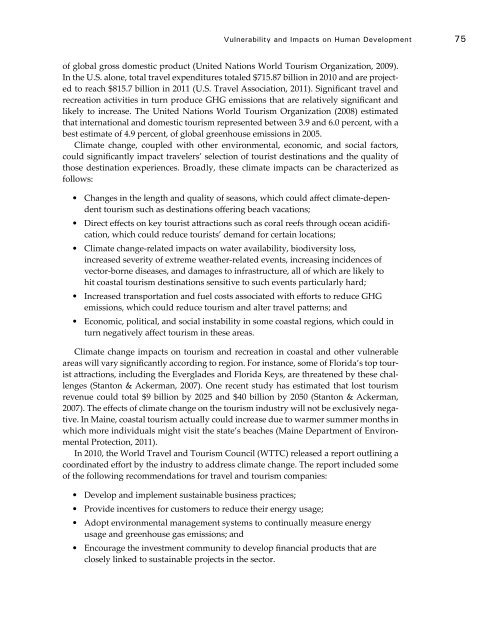Coastal Impacts, Adaptation, and Vulnerabilities - Climate ...
Coastal Impacts, Adaptation, and Vulnerabilities - Climate ...
Coastal Impacts, Adaptation, and Vulnerabilities - Climate ...
You also want an ePaper? Increase the reach of your titles
YUMPU automatically turns print PDFs into web optimized ePapers that Google loves.
Vulnerability <strong>and</strong> <strong>Impacts</strong> on Human Development 75of global gross domestic product (United Nations World Tourism Organization, 2009).In the U.S. alone, total travel expenditures totaled $715.87 billion in 2010 <strong>and</strong> are projectedto reach $815.7 billion in 2011 (U.S. Travel Association, 2011). Significant travel <strong>and</strong>recreation activities in turn produce GHG emissions that are relatively significant <strong>and</strong>likely to increase. The United Nations World Tourism Organization (2008) estimatedthat international <strong>and</strong> domestic tourism represented between 3.9 <strong>and</strong> 6.0 percent, with abest estimate of 4.9 percent, of global greenhouse emissions in 2005.<strong>Climate</strong> change, coupled with other environmental, economic, <strong>and</strong> social factors,could significantly impact travelers’ selection of tourist destinations <strong>and</strong> the quality ofthose destination experiences. Broadly, these climate impacts can be characterized asfollows:• Changes in the length <strong>and</strong> quality of seasons, which could affect climate-dependenttourism such as destinations offering beach vacations;• Direct effects on key tourist attractions such as coral reefs through ocean acidification,which could reduce tourists’ dem<strong>and</strong> for certain locations;• <strong>Climate</strong> change-related impacts on water availability, biodiversity loss,increased severity of extreme weather-related events, increasing incidences ofvector-borne diseases, <strong>and</strong> damages to infrastructure, all of which are likely tohit coastal tourism destinations sensitive to such events particularly hard;• Increased transportation <strong>and</strong> fuel costs associated with efforts to reduce GHGemissions, which could reduce tourism <strong>and</strong> alter travel patterns; <strong>and</strong>• Economic, political, <strong>and</strong> social instability in some coastal regions, which could inturn negatively affect tourism in these areas.<strong>Climate</strong> change impacts on tourism <strong>and</strong> recreation in coastal <strong>and</strong> other vulnerableareas will vary significantly according to region. For instance, some of Florida’s top touristattractions, including the Everglades <strong>and</strong> Florida Keys, are threatened by these challenges(Stanton & Ackerman, 2007). One recent study has estimated that lost tourismrevenue could total $9 billion by 2025 <strong>and</strong> $40 billion by 2050 (Stanton & Ackerman,2007). The effects of climate change on the tourism industry will not be exclusively negative.In Maine, coastal tourism actually could increase due to warmer summer months inwhich more individuals might visit the state’s beaches (Maine Department of EnvironmentalProtection, 2011).In 2010, the World Travel <strong>and</strong> Tourism Council (WTTC) released a report outlining acoordinated effort by the industry to address climate change. The report included someof the following recommendations for travel <strong>and</strong> tourism companies:• Develop <strong>and</strong> implement sustainable business practices;• Provide incentives for customers to reduce their energy usage;• Adopt environmental management systems to continually measure energyusage <strong>and</strong> greenhouse gas emissions; <strong>and</strong>• Encourage the investment community to develop financial products that areclosely linked to sustainable projects in the sector.
















